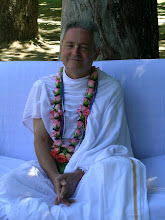“THE SCIENCE OF MEDITATION”
Lecture by Matsya Avatara Dasa
Naples, Castello Angioino, 20th December 2008
Conference “The Science of Meditation”
MAN'S SEARCH FOR HIS OWN IDENTITY
First of all I would like to draw your attention on some cosmogonical aspects that will help us to understand the context where man stands. Today's man has forgotten where he is coming from, he does not know where he is going any more, but above all he does not know who he is, because he is totally identified with an external and temporary identity. This de-contextualization of man is one of the most serious problems that afflict present society and cannot be solved simply through scholarship. The research on one's own self constitutes the basis for meditation, as confirmed by the great texts of the Indo-Vedic tradition such as the Samhitas, Upanishads, Itihasas and Puranas, that can be compared for a very interesting dialogue with the contemporary Western Tradition. Among the many writers and Masters of knowledge that have explored instruments the immense Vedic Culture to get inspiration and concepts for their doctrines and theories, we can mention Carl Gustav Jung and his “individuation of the self”. Individuating one's self means knowing one's deep nature, without being limited by a fallacious and superficial level such as the level of sense perception.
The signals and the information that come to our consciousness from the external environment through the sense organs and the subsequent elaboration at the cortex level only represent a small part of reality, even below the 10% indicated by Prof. Genovesi during the previous presentation. Sense perception is zero compared with the knowledge of reality, and this also applies to our power of comprehension because it is subject to, and thus conditioned by, our sense perception. Therefore not only the senses (indriya) are fallacious, but the mind (manas) that constitutes the collecting area of the perceptive information is fallacious, too, precisely because it is based on sense perception.
The tendency (vasana) of the mind to depend on sensory data leads to the development of a pre-constituted, rigid and generally structured perception of the world, and when this perception is not integrated, it can not be useful to the definition of individual identity. The issue of the nature of personal identity is crucial to the effect of meditation. Indo-Vedic psychology identifies man in his entirety: just like the universe is called "the three worlds" as it is constituted by Earth, intermediate dimensions and Heaven, similarly incarnated man, too, has a threefold nature: physical, psychic and spiritual. The earthly constitution, solid and physical, is the material body, comprising that complex structure - the most complex material structure known to date - that is the Nervous System, but it also possesses a system that, although still material, has a subtler nature that cannot be graphically defined or positioned in space, or even measured in terms of time. Finally, there is the most intimate nature of man, the engine of life itself, its real essence and identity: the spiritual nature. According to Vedic wisdom, each living entity is ontologically atman, an eternal spiritual spark.
To simplify further, we could say that man's identity is split between two aspects connected to the different psycho-physical conditions that the individual has experienced along the various existential cycles of his history. One is the historical or false ego, that is the sum total of the psychic contents with which the individual identifies, called in Sanskrit ahamkara. The other is real, eternal and unchanging, beyond any space and time: his spiritual nature.
The fundamental faculty to access the dimension of meditation is constituted by attention that, contrarily to what is claimed by extreme positivism embraced by modern Western psychology, is not controlled by the Nervous System, but is supported first and foremost by the atman, the unifying center that keeps the personality together and that ultimately offers a unique and special character to the personality. The spiritual self uses the physiological and biological parts of the so-called "human" individual only as an instrument, nourishing and moving his energies. All the Schools of the classic Indian tradition (Sampradayas), all the lineages of the great Masters (acharyas) who have lived the Vedic teachings in their daily life, recognize the atman as the fundamental principle.
In Bhagavad-gita, one of the most popular texts shared by the different Schools of thought of the Indian continent, Krishna defines knowledge as that which distinguishes the field (the body) from the knower of the field (the self). Distancing oneself from the body does not mean rejecting or despising it; this would not be real detachment as what attracts us will eventually repel us. Heraclites also explained this point. In order to go beyond the duality of the opposites - attraction and repulsion, respectively raga and dvesha in Sanskrit - we need to rebalance the opposites, and to find the connection, the harmonization between them. In this harmonization, in this search for balance, in this case in Yoga, meditation is particularly important.





No comments:
Post a Comment